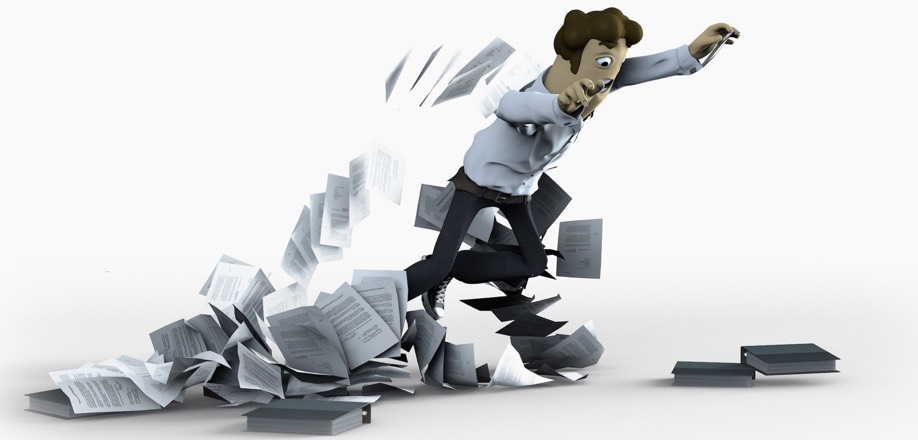


Skiing can result in a broken leg, whiplash from a car accident. When taking part in leisure activities, especially sports, one is aware to a great or lesser degree of the various risks involved. But many accidents also take place in everyday situations, which, at first glance, do not appear to carry any danger. According to current statistics, accidents in the office are far from uncommon. Every year around 15,0001 accidents take place in offices. They result in insurance costs that amount to an average of CHF 74 million per year.
A package is delivered to the office, with cutter in hand and a sense of anticipation –but not the requisite caution – preparations are made to remove the packaging. Or deep in concentration on a concept that has just been printed out, the stack of paper for recycling just outside the copying room that normally presents no problem is overlooked. And that is how quickly cuts and falls can occur in the office.
The risk of accidents in the service sector, for example in financial or insurance companies, architectural firms or administrative companies, is often underestimated. Occupational safety in the office is important precisely because the potential hazards are not obvious or not regarded as serious. People are less aware of the ways in which they can protect themselves against injuries than on construction sites or on the production line where protective equipment is worn.
In order to avoid accidents, it helps to understand where and how they occur. Here is a list of the most common kinds of accident in offices:2
The most common type of accident by far is slipping, sliding or falling. A third (33%) of all recorded occupational accidents are tripping and falling accidents. These frequently take place on staircases. But unmarked raised surfaces, loose cables, and walkways that are partially blocked can also lead to tripping accidents. Wet floors, inadequate lighting or inappropriate shoes often play a role in serious falls.
At 19%, the second most common type of accident is being hit by something or the kickback effect. Included here are collisions with people, objects or transportation aids.
Almost as common (17%) in the office are cuts, scratches or grazes. Care should be taken when using tools such as cutters, cutting machines or scissors as well as when clearing up broken glass.
The fourth most frequent form of accident is hitting, bumping into, grasping an object (13%). For example if a drawer is not immediately closed after it has been opened or if an unmarked glass door is overlooked, a moment of inattention can be quite painful.
Serious accidents as a result of objects tipping over such as shelving or filing cabinets make up 10% of all occupational accidents in offices.
A further 22% of occupational accidents are made up of different types of accidents. They include physical overstrain such as lifting, being driven into, bruising resulting from trapping limbs or digits, inhaling or coming into contact with substances. These can be in the form of cleaning materials or solvents from new flooring materials that in addition to causing burns also cause an allergic reaction.
The question that now arises is how can these accidents be avoided? In order to do so, the causes need to be identified.
Technical and construction defects such as tripping hazards, wear and tear, inadequate space, walkways or escape routes.
Further often underestimated causes of accidents are stress, time pressure, overload or poor communication. Organisational deficiencies have an effect on the work atmosphere and sense of wellbeing. Fatigue, a drop in performance and a higher frequency of errors result in additional time pressure. It is the start of a vicious circle.
Apart from work organization and building maintenance, a determining factor is the awareness and resulting behaviour of each individual. Stairs can easily become a tripping hazard if the focus is on the smartphone display while going upstairs, or when making a last-minute dash from the office to a meeting. Or if, for convenience sake, a chair rather than a stepladder is used as a climbing aid, the consequences can be serious.
Human factors play an important role in the cause and therefore also in the prevention of accidents. A classic example of a tripping accident is handbags, briefcases and wastepaper baskets left in the way. It is easy to avoid this kind of accident at the office: bags should be placed under the table or on a shelf.
In contrast to the construction site, wearing a helmet or boots with steel caps contributes little to safety in the office. What is required is a sense of awareness and a vigilant eye in order to recognise risks and sources of danger.
1 Includes businesses in the service sector that carry out primarily office activities in NOGA 2008 categories: 58, 60, 61, 62, 63, 64, 65, 66, 68, 69, 70, 73, 74, 77, 79, 82, 91, 94. Source: SSUV, UVG statistics 2005-2014, projection based on representative samples.
2 Includes multiple counts; as an accident can have multiple causes the sum total of the individual categories is higher than the total accidents.